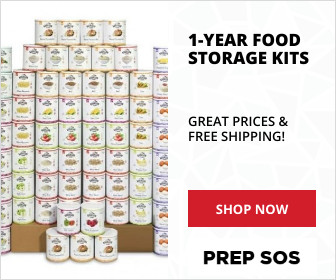
Freeze Dryers are one of the best ways to keep a variety of food for your food storage. Using freeze dryers takes the moisture out of food so that it lasts much longer than it would without being freeze-dried. There are so many different foods and great recipes for freeze-drying, but first, it’s important to find a freeze dryer that will fit all your needs. While they may be an expensive purchase, they are a highly valuable investment for your food storage needs. Click here for the freeze dryers that we recommend.
If you’re into food storage, I’m sure you’re a fan of canning, dehydrating, and store-bought food storage. While these things are great options, freeze-drying food has some great advantages. Unlike canning, freeze-drying causes very little damage to the nutritional value of food. Freeze-dried food retains around 97% of the nutrients while canning and dehydrating eliminate around half of the nutrition. Dehydrating also takes away the color and flavor of your favorite snacks.
Recipes
The following are great items to have in stock for your food storage. The recipes below are inspired by many different websites including Harvest Right, Wholefully, The Survival Mom, and How Does She.
Beans –
If you eat a lot of beans, or are trying to build up your food storage, freeze-drying beans can save a lot of money.
Cook –
- Sort your dried beans. Remove any rotten beans or any other debris.
- Soak overnight or do a quick soak. Soaking before cooking reduces the cooking time. Cover them by about 2 inches and let them soak overnight. Or do a quick soak by covering them by 1 inch and put the heat on high. Bring to a rolling boil and boil for a minute. Then remove beans from the heat, cover, and let soak for an hour. After soaking, whichever method you choose, the beans have expanded and softened quite a bit.
- Cook your beans. Cover the beans in fresh water. Place the beans back on the stove on high, bringing the water to a boil. Cook depending on the type and age of bean.
- Cool the beans. Spread them out onto a baking sheet for quick cooling.
- Divide, label, and freeze.
Freeze –
To freeze the beans, divide them into your different freezing containers. Quart-sized freezer bags work great, and they carry about two cup portions. Put the bags flat and stick them in the freezer for easy use. This will help to prolong their shelf life.
Cheese –
Cheese is used for so many different recipes it’s hard to imagine life without it. Especially for food storage purposes, cheese is a nutritious staple food to have on hand. But how? Cheese goes bad fast. Some cheeses can be waxed, but this can be controversial. Some softer cheeses have too much moisture, so when they’re taken out of the plastic wrap to be waxed, they can end up going rancid. Again, the freeze dryer comes in to save the day. This process keeps the flavor, the smell, and the nutrition, but adds up to 20 years of shelf life.
In order to freeze-dry cheese, all you have to do is slice or grate the cheese, place it on the tray, and just like that, you have cheese that will last you 20 years. You can then add that cheese to anything including casseroles, eggs, pasta, etc.
Eggs –
Eggs are a great source of nutrition and protein! But they are incredibly fragile as they can be cracked, and they expire fast. Luckily, freeze-drying is the solution to this problem. Cooked or raw eggs can be freeze-dried to help this nutritious and delicious food last for much longer than before.
Raw –
Freeze-dried raw eggs can be whisked, freeze-dried and then kept in their freeze-dried form as a powder. They can then be added to a plethora of recipes in substitution for eggs that are not freeze-dried. (Quick Tip: 2 tablespoons of egg powder equal 1 egg)
Cooked –
Eggs can also be scrambled and then placed in the freeze-dryer. This makes it incredibly easy to rehydrate them for a healthy breakfast or snack. They’re easily rehydrated with a little bit of water in a hot skillet.
Ice Cream & Yogurt –
Dairy goes fast, but not with a freeze dryer. With a freeze dryer, you can enjoy your ice cream and yogurt for much longer.
Freeze drying ice cream is a great option. It doesn’t stay as soft and creamy as the original, but it will have that same delicious flavor for years to come. Most people don’t even notice the meringue-like texture as it dissolves very quickly after it is placed in your mouth

Freeze-dried yogurt is a great option because it turns into a powder. It’s great for adding a little extra flavor to smoothies, pancakes, or even pound cake. If frozen in little dollops they can even be a fun healthy snack.
Leafy Greens –
Leafy greens can wilt and turn gross pretty quickly, but with a freeze dryer that can all change. There are many different delicious snack food options. This is also great because you never have to worry about growing too many greens. And this allows for delicious fresh greens all year round.
Freeze Dried Kale –
- Add a spritz of olive oil to your fresh kale.
- Add some of your favorite seasonings on top.
- Freeze dry for a scrumptious healthy chip.
Rehydrated Greens –
You can also rehydrate kale and spinach by adding them into a soup or casserole. If you want to add the leafy greens to a sandwich or salad you can also spritz some water on the greens. These make them as good as fresh.
Powdered Greens –
After being freeze-dried they can easily be crushed and added to smoothies, pancakes and a slew of other things to increase the nutritional value.
Spaghetti –
Spaghetti is a great thing to have freeze-dried and ready to go in your food storage! And it’s easy! All you have to do is make up a couple of batches of your favorite spaghetti recipe. Lay it out on the trays of your freeze dryer and wait for it to be done! After that, you’ll want to make sure that there is no moisture left. Then it’s ready to be vacuum-packed up and stored away for a rainy day.
Meat –
Meat is a great thing to freeze-dry as it’s quick and doesn’t sacrifice any of the flavor. This can be done with a variety of meats. Strips of meat just need to be placed on the trays. The meat then needs to be packaged with an oxygen absorber. This will ensure that the meat will last for the next 10-15 years.

If the meat is cooked, then all you have to do is submerge it in water. Then pull out and pat off the excess water. Then it’s ready to go into your soup, casseroles, tacos, etc. If the meat is raw when freeze-dried, do the same as before. Submerge in water and pat off to dry. After dry, cook it any way you want. Meat is so great freeze-dried because it doesn’t lose any of its flavor or nutritional value.
Steak –
This is a great thing to have available as it’s a tasty and nutritious addition to stews, chilis, tacos, sandwiches, etc.
Dehydrate –
Dice raw steak into large pieces, while removing as much fat as possible. Place the pieces of steak on trays and enter into the freeze dryer. When the freeze-drying is complete, break some of the largest pieces in half. If there are ice crystals in the middle of the steak, it needs some more drying time until there is no ice left.
When it’s completely dry, store the steak in airtight containers or Mylar bags with an oxygen absorber. Then label the bags as raw and record the date they were freeze-dried. When done properly, most meat should last about 10 to 15 years when completely dried and stored in at least a 7 mil mylar bag.
Rehydrate –
Place raw meat in a bowl of cold water and place it in the fridge overnight or until the pieces are rehydrated. The meat won’t accept more water than it needs so there is no concern about over-hydrating.
Quick Tips for Freeze-Dried Foods:
They’re great as a healthy, delicious dry snack!
Most anything can be freeze-dried and then eaten dried. Fruits, ice cream, even yogurt! This makes for a fun and healthy snack for all ages.
Know when to hydrate the food and when not to.
Most of the time it’s a good idea to hydrate your freeze-dried food before using it in a recipe. But sometimes you can save some time by throwing in the freeze-dried version of the food. For example, the ingredients for a soup can just be all added together and then hydrated during the process of making the soup.
Freeze-dried food can still be sautéed.
Many recipes call for sautéed ingredients. This is actually perfect for freeze-dried ingredients. Throw some oil on the pan, throw in your dry ingredients, and then you will have delicious sautéed ingredients ready to be used in your recipe. Water will need to be added quickly to avoid burning the fragile food.
Less is more when it comes to rehydration.
It’s important to make sure that food isn’t overhydrated as then it gets soggy. A good way to make sure the food doesn’t get too soggy or hydrated is to gather all the food you want to hydrate. Then put them in either a glass cup or bowl. Put just enough water to make the food float in the cup or pool in the bowl. Then stir around the food until all the food is hydrated.
I hope you enjoyed this article and found some good ideas here for your freeze-drying needs! Click here for the freeze dryers that we recommend.




